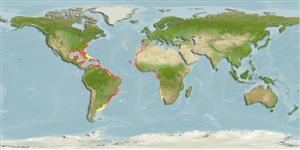Preferred temperature (Ref.
115969): 15.8 - 27, mean 21.7 (based on 178 cells).
Phylogenetic diversity index (Ref.
82804): PD
50 = 0.5000 [Uniqueness, from 0.5 = low to 2.0 = high].
Bayesian length-weight: a=0.00457 (0.00292 - 0.00715), b=3.08 (2.96 - 3.20), in cm Total Length, based on LWR estimates for this species & Genus-body shape (Ref.
93245).
Nivel trófico (Ref.
69278): 4.6 ±0.0 se; based on diet studies.
Resiliencia (Ref.
120179): Muy bajo, población duplicada en un tiempo mínimo superior a 14 años (tm=8-10; Fec=4; Tmax=17; K=0.12).
Fishing Vulnerability (Ref.
59153): High to very high vulnerability (73 of 100).
